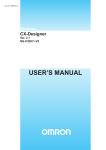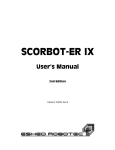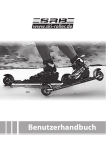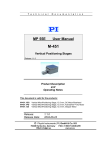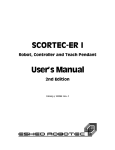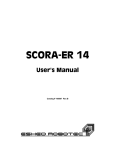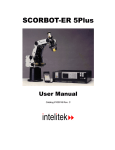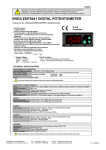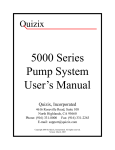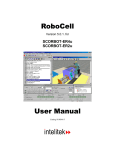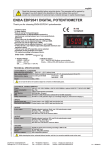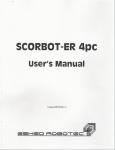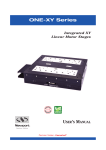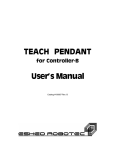Download 100082-a PerformerMK2
Transcript
2'4(14/'4//-4 7UGTIU"/CPWCN This publication is valid for use with ACL version 2.27 and ATS version 1.82. Catalog # 100082 9#40+0)"# 2'4(14/'4//-4 KU"�)'4175 CPF"ECP"ECWUG"UGXGTG"KPLWT[0 75'"9+6*"':64'/'"%#76+100 5GV"WR"C"RTQVGEVKXG"UETGGP"QT"IWCTFTCKN CTQWPF"VJG"TQDQV"VQ -''2"2'12.'"#9#; HTQO"KVU"YQTMKPI"TCPIG0 Copyright © 1994–1999 by Eshed Robotec (1982) Limited. Catalog #100082 Rev.A (November 1994) May 1999 Reprinted/PDF version Every effort has been made to make this book as complete and accurate as possible. However, no warranty of suitability, purpose, or fitness is made or implied. Eshed Robotec is not liable or responsible to any person or entity for loss or damage in connection with or stemming from the use of the software, hardware and/or the information contained in this publication. Eshed Robotec bears no responsibility for errors which may appear in this publication and retains the right to make changes to the software, hardware and manual without prior notice. ACL is a trademark of Eshed Robotec (1982) Ltd. Read this manual thoroughly before attempting to install or operate the robot. If you have any problems during installation or operation, call your agent for assistance. Save the original carton and all packing material. You may need them later for shipment. Table of Contents CHAPTER 1 Unpacking and Handling Unpacking the Robot . . Handling Instructions . . Acceptance Inspection . Repacking for Shipment CHAPTER 2 . . . . . . . . . . . . . . . . . . . . . . . . . . . . . . . . . . . . . . . . . . . . . . . . . . . . . . . . . . . . . . . . . . . . . . . . . . . . 1-1 1-1 1-2 1-3 Specifications Structure . . . . . . . . . . . . . . . . . . . . . . . . . . . 2-2 Work Envelope . . . . . . . . . . . . . . . . . . . . . . . . 2-4 CHAPTER 3 Safety Precautions . . . . . . . . . . . . . . . . . . . . . . . . . 3-1 Warnings . . . . . . . . . . . . . . . . . . . . . . . . . . . 3-2 CHAPTER 4 Installation Preparations . . . . . . . . . . . . . . . . . Controller and Computer/Terminal Setup Robot Setup . . . . . . . . . . . . . . . PERFORMER-MK2 Installation . . . . . . . Controller Installation . . . . . . . . . . Robot Installation . . . . . . . . . . . . Homing the Robot . . . . . . . . . . . . Gripper Installation . . . . . . . . . . . . . . Pneumatic Gripper . . . . . . . . . . . . DC Servo Gripper . . . . . . . . . . . . Activating the Gripper . . . . . . . . . . CHAPTER 5 9411 . . . . . . . . . . . . . . . . . . . . . . . . . . . . . . . . . . . . . . . . . . . . . . . . . . . . . . . . . . . . . . . . . . . . . . . . . . . . . 4-1 4-1 4-1 4-2 4-2 4-2 4-3 4-5 4-5 4-7 4-9 . . . . . . . . . . . . . . . . . . . . . . . . . . . . . . . . . . . . . . . . . . . . . . . . . . . . . . . . . . . . . . . . . . . . . . . . 5-2 5-2 5-2 5-3 5-4 5-5 5-5 5-5 5-6 Operation Robot Operating Software . . . . . . . . ACL . . . . . . . . . . . . . . . . . ATS . . . . . . . . . . . . . . . . . Teach Pendant . . . . . . . . . . . . . . Homing the Robot . . . . . . . . . . Coordinate Systems . . . . . . . . . Cartesian (XYZ) Coordinates . . JOINT Coordinates . . . . . . . Defining the Coordinate System User’s Manual . . . . . . . . . . . PERFORMER-MK2 . . . . . . . . . . . . . . . . . . vii Moving the Axes . . . . . . . . . . . . Servo Control . . . . . . . . . . . Axis Control Group . . . . . . . . XYZ and JOINT Movements . . . Setting the Speed . . . . . . . . . . . Recording Positions . . . . . . . . . . Moving to Recorded Position . . . . . ACL Commands . . . . . . . . . . . . . . Homing the Robot and Peripheral Axes Manual Mode . . . . . . . . . . . . . Coordinate Systems . . . . . . . . . . Moving the Axes . . . . . . . . . . . . Servo Control . . . . . . . . . . . JOINT Movements . . . . . . . . XYZ Movements . . . . . . . . . . Setting the Speed . . . . . . . . . . . Recording Positions . . . . . . . . . . Defining Positions . . . . . . . . . Recording Positions . . . . . . . . Moving to Recorded Positions . . . . . Summary of Commands: Quick Reference CHAPTER 6 . . . . . . . . . . . . . . . . . . . . . . . . . . . . . . . . . . . . . . . . . . . . . . . . . . . . . . . . . . . . . . . . . . . . . . . . . . . . . . . . . . . . . . . . . . . . . . . . . . . . . . . . . . . . . . . . . . . . . . . . . . . . . . . . . . . . . . . . . . . . . . . . . . . . . . . . . . . . . . . . . . . . . . . . . . . . . . . . . . . . . . . . . . . . . 5-6 5-6 5-7 5-7 5-8 5-8 5-9 5-10 5-10 5-11 5-11 5-11 5-11 5-12 5-12 5-13 5-13 5-13 5-14 5-14 5-15 Maintenance Daily Operation . . . . . . . . . . . . . . . . . . . . . . . . 6-1 Periodic Inspection . . . . . . . . . . . . . . . . . . . . . . 6-2 Troubleshooting . . . . . . . . . . . . . . . . . . . . . . . 6-3 CHAPTER 7 Components Axis 1 and Shoulder Assembly . . . . . . . Axis 2, Axis 3 and Upper Arm Assembly . . . Axis 4. Axis 5, Forearm and Wrist Assembly Replacement Parts . . . . . . . . . . . . . . viii PERFORMER-MK2 . . . . . . . . . . . . . . . . . . . . . . . . . . . . . . . . 7-2 7-4 7-7 7-10 User’s Manual 9411 CHAPTER 1 Unpacking and Handling This chapter contains important instructions for unpacking and inspecting the PERFORMER-MK2 robot arm. N Read this chapter carefully before you unpack the PERFORMER-MK2 robot and controller. Unpacking the Robot The robot is packed in expanded foam. To protect the robot during shipment, the gripper-mounting flange and the robot base are bolted to a metal anchor plate. Use a hex socket wrench to detach these bolts. Save these bolts and the anchor plate. You will need them should you repack the robot for shipment. Save the original packing materials and shipping carton. You may need them later for shipment or for storage of the robot. Handling Instructions The robot arm weighs 27.7 kilos (61 lbs) Lift and carry the robot arm by grasping its body and/or base. Do not lift or carry the robot arm by its upper arm or forearm. Axis 2 and axis 3 have braking mechanisms. Do not forcibly move these axes; doing so will damage these axes. User’s Manual 9411 PERFORMER-MK2 1-1 Acceptance Inspection After removing the robot arm from the shipping carton, examine it for signs of shipping damage. If any damage is evident, do not install or operate the PERFORMER-MK2. Notify your freight carrier and begin appropriate claims procedures. The following items are standard components in the PERFORMER-MK2 package. Make sure you have received all the items listed on the shipment’s packing list. If anything is missing, contact your supplier. Item PERFORMER-MK2 Robot Arm Gripper (optional: 2 options) Controller-B Description Includes: Cabling with air hoses; Hardware for mounting robot: 4 sets of bolt, washer, nut. Pneumatic Gripper includes: Pneumatic solenoid valve; Hardware for mounting gripper: flange adapter, 6 screws. Electrical DC Servo Gripper with encoder includes: Hardware for mounting gripper: flange adapter, 4 screws. Includes: Power Cable 100/110/220/240VAC; RS232 Cable; 4 driver cards (for 8 axes); (Optional: 3 driver cards for 6 axes) Optional: Additional driver cards for control of up to 12 axes; Auxiliary multiport RS232 board, cable and connectors. Teach Pendant (optional) Software Documentation ATS (Advanced Terminal Software): 2 diskettes; one is write-protected PERFORMER-MK2 User’s Manual Controller-B User’s Manual ACL and ATS Reference Guide (with update for Controller-B) Repacking for Shipment Be sure all parts are back in place before packing the robot. When repacking the robot for shipping, bolt the flange and base to the metal anchor plate. Failure to do so may result in irreversible damage to the arm, particularly to the harmonic drive transmissions. Also be sure to secure the cables around the foam spool. The robot should be repacked in its original packaging for transport. If the original carton is not available, wrap the robot in plastic or heavy paper. Put the wrapped robot in a strong cardboard box at least 15 cm (about 6 inches) longer in all three dimensions than the robot. Fill the box equally around the unit with resilient packing material (shredded paper, bubble pack, expanded foam chunks). Seal the carton with sealing or strapping tape. Do not use cellophane or masking tape. User’s Manual 9411 PERFORMER-MK2 1-3 Á CHAPTER 2 Specifications The following table gives the specifications of the PERFORMER-MK2 robot arm. Mechanical Structure Number of Axes Axis Movement Axis 1: Base rotation Axis 2: Shoulder rotation Axis 3: Elbow rotation Axis 4: Wrist pitch Axis 5: Wrist roll Maximum Operating Radius End Effector Hard Home Feedback Actuators Transmission Maximum Payload Position Repeatability Weight Ambient Operating Temperature User’s Manual 9411 Robot Arm Specifications Vertical articulated 5 plus gripper Axis Range 305° 185° 235° 225° Effective Speed 150°/sec 90°/sec 140°/sec 180°/sec ∞ 250°/sec 700 mm (27.45") at flange Pneumatic Gripper Electrical (DC servo) Gripper Maximum Opening: 75mm (3") Fixed position on all axes Incremental optical encoders with index pulse DC servo motors Harmonic drive 2 kg (4.4 lb.), including gripper ±0.05mm (0.002") 27.7 kilo (61 lbs) 2°–40°C (36°–104°F) PERFORMER-MK2 2-1 Structure The PERFORMER-MK2 is a vertical articulated robot, with five revolute joints. With gripper attached, the robot has six degrees of freedom. This design permits the end effector to be positioned and oriented arbitrarily within a large work space. Figures 2-1 and 2-2 identify the joints and links of the mechanical arm. Each joint is driven by a permanent magnet DC motor via a harmonic drive gear transmission. The movements of the joints are described in the following table: Axis No. Joint Name Motion Motor No. 1 Base (Waist) Rotates the body. 1 2 Shoulder Raises and lowers the upper arm. 2 3 Elbow Raises and lowers the forearm. 3 4 Wrist Pitch Raises and lowers the end effector. 4 5 Wrist Roll Rotates the end effector. 5 Figure 2-1: Joints - Top View Figure 2-2: Links - Side View User’s Manual 9411 PERFORMER-MK2 2-3 Work Envelope The length of the links and the degree of rotation of the joints determine the robot’s work envelope. Figure 2-3 shows the dimensions and reach of the PERFORMER-MK2, while Figure 2-4 gives a top view of the robot’s work envelope. The base of the robot is normally fixed to a stationary work surface. It may, however, be attached to a slidebase, resulting in an extended working range. Figure 2-3: Operating Range (Side View) Figure 2-4: Operating Range (Top View) CHAPTER 3 Safety The PERFORMER-MK2 is a potentially dangerous machine. Safety during operation is of the utmost importance. Use extreme caution when working with the robot. Precautions The following chapters of this manual provide complete details for proper installation and operation of the PERFORMER-MK2. The list below summarizes the most important safety measures. 1. Make sure the robot base is properly and securely bolted in place. 2. Make sure the robot arm has ample space in which to operate freely. 3. Make sure a guardrail or rope has been set up around the PERFORMER-MK2 operating area to protect both the operator and bystanders. 4. Do not enter the robot’s safety range or touch the robot when the system is in operation. 5. Press the controller’s EMERGENCY switch before you enter the robot’s operating area. 6. Turn off the controller’s POWER switch before you connect any inputs or outputs to the controller. 7. Be sure you know how to immediately abort running pograms and movements. N User’s Manual 9411 To immediately abort all running programs and stop all axes of motion: press the Abort key on the teach pendant, or use the ACL command A <Enter>, or press the controller’s red EMERGENCY button. PERFORMER-MK2 3-1 Warnings 1. Do not operate the PERFORMER-MK2 until you have thoroughly studied both this User’s Manual and the Controller-B User’s Manual. Be sure you follow the safety guidelines outlined for both the robot and the controller. 2. Do not install or operate the PERFORMER-MK2 under any of the following conditions: 3. • Where the ambient temperature drops below or exceeds the specified limits. • Where exposed to large amounts of dust, dirt, salt, iron powder, or similar substances. • Where subject to vibrations or shocks. • Where exposed to direct sunlight. • Where subject to chemical, oil or water splashes. • Where corrosive or flammable gas is present. • Where the power line contains voltage spikes, or near any equipment which generates large electrical noises. Do not abuse the robot arm: • Do not overload the robot arm. The combined weight of the workload and gripper may not exceed 2kg (4.4 lb.). It is recommended that the workload be grasped at its center of gravity. • Do not use physical force to move or stop any part of the robot arm. • Do not drive the robot arm into any object or physical obstacle. CHAPTER 4 Installation Preparations Before you make any cable connections, set up the system components according to the following “ Preparation” instructions. Controller and Computer/Terminal Setup Place the controller and computer at a safe distance from the robot—well outside the robot’s safety range. Make sure the setup complies with the guidelines defined in the Controller-B User’s Manual. Robot Setup 1. Set up the PERFORMER-MK2 on a sturdy surface with at least one meter of free space all around the robot. 2. Fasten the base of the robot to the work surface with four sets of M8 bolt, washer and nut. Make sure the robot is securely bolted in place. Otherwise the robot could become unbalanced and topple over while in motion. 3. User’s Manual 9411 Set up a guardrail or rope around the PERFORMER-MK2 operating area to protect both the operator and bystanders. PERFORMER-MK2 4-1 PERFORMER-MK2 Installation Controller Installation N Be sure the controller and computer are properly installed before you install the robot. Perform the installation procedures detailed in the following sections of Chapter 2, “ Installation,” in the Controller-B User’s Manual: Computer/Terminal–Controller Installation Power On Controller Configuration After you have installed the computer/terminal and controller, and verified that the system is functioning, you may proceed with the robot installation. Robot Installation N Before you begin, make sure the controller POWER switch is turned off. The robot cable has a number of connectors. Connect them to the controller according to following three steps. Refer to Figure 4-1. 1. Connect the green/yellow wire to the Safety Ground: Unscrew and remove the ground nut and washer from the Safety Ground stud. Place the ground wire terminal onto the stud, then replace and tighten the washer and nut. 2. Plug the the D37 connector into the Robot Encoders port. Tighten the retaining screws on the connector. 3. Plug the 19-pin round connector into the Robot Power port. AIR HOSES (for pneumatic gripper only) 2 3 1 Figure 4-1: Robot— Controller Cable Connections 4-2 PERFORMER-MK2 User’s Manual 9411 Homing the Robot After you have completed the robot installation (including the ATS procedure for controller configuration), execute the robot’s Home routine, as described below. N The robot should be homed before the gripper is mounted in order to verify the orientation of the flange when the robot is at home. N Before you begin the homing procedure, make sure the robot has ample space in which to move freely and extend its arm. 1. Turn on the controller power and motor switches. Turn on the computer. 2. From the ATS diskette or directory, type go <Enter> or term_acl <Enter> (If the controller is connected to computer port COM2, type: go /c2 <Enter> or term_acl /c2 <Enter> 3. When the ATS main screen and prompt appear on the monitor, you may proceed. 4. Give the command to home the robot. You may do so from either they keyboard or the teach pendant, as described below. During the homing procedure, the robot joints move and search for their home positions in the following sequence: shoulder, elbow, pitch, roll, base. From the keyboard, type: home <Enter> The monitor will display: WAIT!! HOMING... If home is found, a message is displayed: HOMING COMPLETE (ROBOT) If the homing procedure is not completed, an error message identifying the failure is displayed. For example: *** HOME FAILURE AXIS 3 If the home switch is found, but not the encoder’s index pulse, the following message is displayed: * * * INDEX PULSE NOT FOUND AXIS 2 User’s Manual 9411 PERFORMER-MK2 4-3 From the teach pendant, key in the command to execute the homing program: Run 0 Enter The display panel on the teach pendant will show: HOMING . . . A JOINTS When the Home search is successfully completed, the display panel will show: HOMING COMPLETE A JOINTS 4-4 PERFORMER-MK2 User’s Manual 9411 Gripper Installation L The robot must be homed before you mount the gripper. Pneumatic Gripper The pneumatic gripper, shown in Figure 4-2, is controlled by a 5/2 solenoid pneumatic valve which is activated by one of the controller’s relay outputs. The valve may be 12VDC or 24VDC and can draw its power from the controller’s User Power Supply. 1. Turn on the computer and the controller. Activate ATS . 2. Press <Ctrl>+F1 to activate the controller configuration procedure, or press <Ctrl>+F4 to immediately call up the Extended Definition menu. Figure 4-2: Pneumatic Gripper In the Extended Definition menu, define the relay output which will drive the pneumatic gripper. Also define the output state (0 or 1) for a closed gripper, and the time required to complete execution of an open/close command. For more complete instructions, refer to the configuration procedures in the ATS software documentation. 3. Home the robot. 4. Using four M5x10 socket screws and a 4mm Allen key (hex wrench), attach the gripper adapter plate to the flange at the end of the robot arm, as shown in Figure 4-3. 5. Using four M4x10 socket screws and a 3mm Allen key, attach the gripper to the adapter plate. 6. Connect the two hoses from the gripper to the nipples on the robot’s forearm (refer to Figure 4-8). FLANGE ADAPTER Figure 4-3: Attaching Gripper Adapter Plate to Flange User’s Manual 9411 PERFORMER-MK2 4-5 7. 8. Refer to Figure 4-4. • Connect the two transparent 1/4" O.D. hoses from the robot cable to the CYL ports on the pneumatic valve. • Connect a 5 bar/90 PSI air supply to the IN port on the valve. Refer to Figure 4-5. Connect the valve to the controller’s User Power Supply as follows: 4-6 Figure 4-4: Pneumatic Solenoid Valve • Connect one wire to a ground terminal. • Connect the other wire to the normally open (NO) terminal of the relay output (which you specified in the Extended Definition). 7. Connect 12VDC or 24VDC (in accordance with your valve’s specification) to the common (C) terminal of the same relay output, as shown in Figure 4-5. 8. Attach the valve to the controller or any other metalic surface by means of the valve’s magnetic base. Figure 4-5 Valve— Controller Connections PERFORMER-MK2 User’s Manual 9411 DC Servo Gripper The DC servo gripper, shown in Figure 4-6, is controlled in the same manner as the robot’s five servo axes. The default controller configuration reserves axis 6 for a servo gripper; however, the proper parameters for the gripper must be loaded. 1. Figure 4-6: DC Servo Gripper 2. Turn on the computer and the controller. Activate ATS. 3. Load the gripper parameters in either one of the following ways: • Insert the diskette provided with the gripper into your computer disk drive. Press <Shift>+F10 to activate the Backup Manager. Use the following options to load the parameter file GRPMK2 from the diskette: “ Restore PARAMETERS” and “ RESTORE from disk (F5)” . • Make sure ATS’s “ Working Directory” is the directory or drive in which the GRPMK2 file is located. Press <Ctrl>+F1 to activate the controller configuration procedure, or press <Ctrl>+F4 to immediately call up the Extended Definition menu. In the Extended Definition menu, select Gripper Type: Servo, followed by F10. 4. Home the robot. 5. Using four M5x10 socket screws and a 4mm Allen key (hex wrench), attach the gripper adapter plate to the flange at the end of the robot arm, as shown in Figure 4-3. 6. Using four M4x10 socket screws and a 3mm Allen key, attach the gripper to the adapter plate, as shown in Figure 4-7. 7. Gently connect the gripper cable to the D9 connector on the robot arm, as indicated in Figure 4-8. Make sure the gripper cable is positioned as shown in Figure 4-8. 8. Carefully execute the robot HOME command. Stay close to the teach pendant or controller. If the gripper cable becomes entangled or excessively stretched during the homing, abort the procedure immediately. User’s Manual 9411 Before you install the DC servo gripper, make sure the ACL EPROMs in your Controller-B are Version 2.26 or later. Upgrade the EPROMs if necessary. PERFORMER-MK2 4-7 9. 10. The gripper has a rotation of ±270°. Do not attempt to move the gripper beyond this limit. At the end of each work session (before turning off the controller), or before homing the robot, make sure the gripper’s position is as shown in Figure 4-8. Figure 4-7: Mounting DC Servo Gripper (side view) Figure 4-8: DC Servo Gripper Cable Connection (top view) 4-8 PERFORMER-MK2 User’s Manual 9411 Activating the Gripper After you have installed either the electric or pneumatic gripper, open and close it in order to verify that it is functioning. From the keyboard, type: The gripper opens. The gripper closes. open <Enter> close <Enter> From the teach pendant, key in: Open/Close The Open/Close key toggles the gripper between its open and closed states. User’s Manual 9411 PERFORMER-MK2 4-9 Á 4 - 10 PERFORMER-MK2 User’s Manual 9411 CHAPTER 5 Operation This chapter will introduce you to the basic commands for operating the PERFORMER-MK2 robot by means of both the ACL software and the teach pendant. Figure 5-1 shows the components of the robotic system, and indicates how they interact. Figure 5-1: Robotic System User’s Manual 9411 PERFORMER-MK2 5-1 Robot Operating Software ACL ACL, Advanced Control Language, is an advanced, multi-tasking robotic programming language developed by Eshed Robotec. ACL is programmed onto a set of EPROMs within Controller-B, and can be accessed from any standard terminal or PC computer by means of an RS232 communication channel. ACL features include the following: • Direct user control of robotic axes. • User programming of robotic system. • Input/output data control. • Simultaneous and synchronized program execution (full multi-tasking support). • Simple file management. The ACL Reference Guide provides detailed descriptions and examples of the ACL commands. ATS ATS, Advanced Terminal Software, is the user interface to the ACL controller. ATS is supplied on diskette and operates on any PC host computer. The software is a terminal emulator which enables access to ACL from a PC computer. ATS features include the following: • Short-form controller configuration. • Definition of peripheral devices. • Short-cut keys for command entry. • Backup manager. • Print manager. More information on ATS can be found in the ACL Reference Guide (and its update for Controller-B). 5-2 PERFORMER-MK2 User’s Manual 9411 Teach Pendant The teach pendant (TP), shown in Figure 5-2, is a hand-held terminal, used for controlling the PERFORMER-MK2 robot and peripheral equipment. The teach pendant is most practical for moving the axes, recording positions, sending the axes to recorded positions and activating programs. Other functions can also be executed from the teach pendant. N Make sure the teach pendant is connected to the controller before you power on the system. The teach pendant’s display panel is a 2-line, 32-character liquid crystal display (LCD). It shows the current status of the controller, the current user command, and system messages. The teach pendant’s keypad has 30 color-coded keys. Most of the keys are multi-functional; for example, some keys include both an axis drive command and a numeric function. The controller recognizes the keys from the order in which they are pressed. Figure 5-2: Teach Pendant Layout User’s Manual 9411 PERFORMER-MK2 5-3 Homing the Robot The location of the robot axes is monitored by encoders which track the amount of movement relative to an initial position. To obtain repeatable robot performance, this initial position—home—must be identical each time the robot is used. Thus, whenever the system is activated, the homing program, which is internally programmed into the controller, must be executed. During the homing procedure, the robot joints move and search for their home positions, one at a time, in the following sequence: shoulder (axis 2), pitch (axis 4) elbow (axis 3), roll (axis 5), base (axis 1). To find its home position, the axis is moved until the optical detector which is mounted on the joint sends a specific signal to the controller. The axis motor continues to rotate until its encoder produces an index pulse. At that point, the axis is at home. When the homing is completed, the robot assumes a position in which the upper arm and forearm are nearly vertical, and the pitch is nearly horizontal. N Key in: Before you begin the homing procedure, make sure the robot has ample space in which to move freely and extend its arm. Run 0 Enter This instructs the controller to execute Program 0, the robot homing routine. The display panel on the teach pendant will show: HOMING . . . When the Home search is successfully completed, the display panel will show: HOMING COMPLETE If the robot is unable to find a home position in one or more of the axes, you will see a message such as: HOME FAIL [4] To stop the homing while the operation is in progress, press the Abort key. N The Home routine must be executed at the beginning of each working session. Otherwise the controller will not execute the commands for recording positions and moving to recorded positions. The peripheral axes must be homed by means of the ACL commands HOME and HHOME, as described later in this chapter. 5-4 PERFORMER-MK2 User’s Manual 9411 Coordinate Systems The PERFORMER-MK2 can be operated and programmed in two different coordinate systems: JOINTS and Cartesian (XYZ) coordinates. Cartesian (XYZ) Coordinates The Cartesian, or XYZ, coordinate system is a geometric system used to specify the position of the robot’s TCP (tool center point) by defining its distance, in linear units, from the point of origin (the center bottom of its base) along three linear axes, as illustrated in Figure 5-3. To complete the position definition, the pitch and roll are specified in angular units. When robot motion is executed in XYZ mode, all or some of the axes move in order to move the TCP along an X, Y, and/or Z axis. Figure 5-3: Cartesian Coordinates JOINT Coordinates Joint coordinates specify the location of each axis in encoder pulses. When the axes move, the optical encoders generate a series of alternating high and low electrical signals. The number of pulses generated is proportional to the amount of axis motion. The controller counts the pulses and determines how far an axis has moved. Similarly, a robot movement or position can be defined as a specific number of counts for each axis, relative to the home position, or another coordinate. When robot motion is executed in JOINT mode, individual axes move according to the command. If any peripheral devices are connected to the robotic system, the position of their axes is always stated in encoder counts User’s Manual 9411 PERFORMER-MK2 5-5 Defining the Coordinate System To toggle between the two coordinate systems: Key in: XYZ/Joints A Key in again: JOINTS XYZ/Joints A XYZ The display reflects the currently active coordinate system. Manual movement of the axes will be executed according to the currently active coordinate system. Moving the Axes Servo Control The controller must be in the servo control (CON) state for the robot to execute movement commands. Activating the Home routine will abort all other programs and activate CON. Certain events, such as impact, overheating (thermic error), or activation of the EMERGENCY switch, will automatically switch off the servo control state (COFF). CON must be activated to resume motion and servo control. To toggle servo control on and off: Key in: Control On/Off CONTROL Key in again: ENABLED Control On/Off CONTROL DISABLED When Control On/Off is activated from the teach pendant, the CONTROL ENABLED/DISABLED messages also appear on the computer screen. 5-6 PERFORMER-MK2 User’s Manual 9411 Axis Control Group By default, the controller assumes the five robot axes (Group A) are under servo control. The Group Select key allows you to switch control to peripheral axes (Group B), or to an independent axis (C). To select the axis control group: Key in: Group Select _ B Key in again: JOINTS Group Select AXIS . . When selecting an independent AXIS, you must also key in the axis number followed by [Enter]. Continue pressing this key until the desired axis group is displayed. XYZ and JOINT Movements When the coordinate system is set to the XYZ mode, movement commands cause linear motion of the tool center point (TCP) along the X, Y and Z axes, while keeping the tool’s pitch and roll angles constant in relation to the robot’s point of origin. When in XYZ mode, the controller recognizes the XYZ, pitch and roll functions of the teach pendant keys. When in JOINT mode, the controller recognizes the joint functions (shaded in diagram) of the teach pendant keys. When the coordinate system is set to the JOINT mode, the robot responds to movement commands by moving from one defined point to another. Peripheral axes always move according to JOINT coordinates. User’s Manual 9411 PERFORMER-MK2 5-7 Setting the Speed The speed of the robot during Go Position movements controlled from the teach pendant is defined as a percentage of maximum speed. Speed defined as 100 gives the robot maximum speed, while a speed of 1 is the minimum. When the system is first turned on, the default speed is set at 50, approximately half the robot’s maximum speed. The speed of the robot during manual movements controlled from the teach pendant is relative to the speed setting, and much slower than Go Position movements. Use the teach pendant to set the robot’s speed to a speed of 30%, for example: Key in: Speed 3 0 Enter All Go Position movement commands will be executed at a speed of 30, until a different speed is entered. Recording Positions N Be sure you have homed the axes before you attempt to record positions or send the axes to recorded positions. The teach pendant allows you to simultaneously record a position’s identifying number and its coordinates. To record a position, use the movement keys to bring the robot to any position. (First be sure the Group Select mode is set to A). For example: Key in: Record Position 1 2 Enter This records the JOINT coordinates of position 12. DONE Move the robot to another position and record it as position 13. The Record Position key records the position of the currently active axis group (A, B or an independent axis) in JOINT coordinates. If you want to define the location of both the robot and the peripheral axes, you must record two positions, one for each group. 5-8 PERFORMER-MK2 User’s Manual 9411 Moving to Recorded Position Once a position has been recorded, you can easily send the robot or other devices connected to the controller to that position. Depending on the currently active coordinate system, the movement of the robot (Group A) will be either point to point (in JOINT mode) or along a linear curve (in XYZ mode). Assuming the robot is at position 13, send the robot back to position 12. Key in: Go Position 1 2 Enter DONE The command Go Position 0 sends all the axes of group A to their home position. If you accidently record another position as 0, execute the Home program. At the completion of the homing routine the system records the proper home positions as 0. User’s Manual 9411 PERFORMER-MK2 5-9 ACL Commands The previous section described the teach pendant commands for homing the robot, selecting coordinate systems and axis control groups, moving the robot at different speeds and recording positions. This section presents the equivalent ACL commands. Homing the Robot and Peripheral Axes N The Home routine must be executed at the beginning of each working session. Otherwise the controller will not execute the commands for recording positions and moving to recorded positions. To home the robot axes (Group A): Type: home <Enter> WAIT!! HOMING... If all axes reach their Home postion, a message is displayed: HOMING COMPLETE (ROBOT) If the HOME process is not completed, an error message identifying the failure is displayed: *** HOME FAILURE AXIS 4 If the home switch is found, but not the encoder’s index pulse, the following message is displayed: *** INDEX PULSE NOT FOUND AXIS 2 To home peripheral axes, each axis must be homed individually; for example: Type: home home home home 7 <Enter> 9 <Enter> 11 <Enter> 12 <Enter> To home an axis, such as a slidebase, which uses a hard stop rather than a microswitch, the HHOME command is used: Type: hhome 8 <Enter> To stop the homing while the operation is in progress, use the Abort commands: Type: or: 5 - 10 A <Enter> <Ctrl>+A PERFORMER-MK2 User’s Manual 9411 Manual Mode If a teach pendant is not available, you can use your terminal/computer keyboard to control the robot’s movements. To enable robot movement by means of the keyboard, you must first activate Manual mode. Type: <Alt> + m MANUAL MODE! >_ JOINTS MODE XYZ MODE or The system’s response indicates the currently active coordinate system. To exit Manual mode, the same command is used. Type: <Alt> + m EXIT MANUAL MODE... >_ Coordinate Systems When Manual mode is active, you can set the coordinate system. To activate the JOINT coordinate system: Type: j JOINT MODE To activate the XYZ coordinate system: Type: X XYZ MODE Moving the Axes Servo Control When Manual mode is active, you can switch servo control on and off. Type: c CONTROL ENABLED or: f CONTROL DISABLED The commands C and F enable and disable control of all axes which are connected to the controller. User’s Manual 9411 PERFORMER-MK2 5 - 11 If Manual mode is not active, you can use the ACL commands CON and COFF for more specific activation of the axes. For example: coff coffb cona con 10 Disables control of all connected axes. Disables control of peripheral axes (Group B). Enables control of robot axes (Group A). Enables control of axis 10. JOINT Movements To directly control movement of the robot axes, Manual mode must first be activated. The following keys can then be used to move the robot: Type: 1, 2, 3, 4, 5, 6, Q W E R T Y Move axis 1 (base) Move axis 2 (shoulder) Move axis 3 (elbow) Move axis 4 (wrist pitch) Move axis 5 (wrist roll) Open/Close electrical servo gripper (axis 6) The axes will move as long as the activating key is depressed, until a fixed stop is reached. The gripper will either open completely or close completely. If peripheral axes are connected, the following keys are also used: Type: 7, 8, 9, 0, –, =, U I O P [ ] Move axis 7 Move axis 8 Move axis 9 Move axis 10 Move axis 11 Move axis 12 XYZ Movements In XYZ mode the following changes in manual movement occur: Type: 1, 2, 3, 4, Q W E R TCP moves along X+ and X– axes. TCP moves along Y+ and Y– axes. TCP moves along Z+ and Z– axes. Pitch moves; TCP maintains position. All other movements are the same as in JOINT mode. 5 - 12 PERFORMER-MK2 User’s Manual 9411 Setting the Speed When Manual mode is active you can set the speed of manual movement. Type: s SPEED.._ You are prompted for a speed value—a percentage of the maximum speed. Type a number between 1–100, and press <Enter>. When Manual mode is not active, the ACL commands SPEED and SPEEDL are used to define the speed at which joint movements and linear movements are executed. For example: speed 50 Sets speed of joint movements of Group A axes to 50% of maximum speed. speedb 20 Sets speed of joint movements of peripheral axes (Group B) to 20% of maximum speed. speedl 20 Sets speed of linear/circular robot movements to 20 mm/sec. For more complete information, refer to the ACL update for Controller-B. Recording Positions N Be sure you have homed the axes before you attempt to record positions or send the axes to recorded positions. Defining Positions Two types of position names are possible: • Numerical names (such as 3, 22, 101) of up to five digits. Robot (group A) positions with this type of name do not need to be defined before they are recorded; the position recording commands automatically define and record robot positions with numerical names. • Alphanumeric names (such as P, POS10, A2). The name may be a combination of up to five characters, and should begin with a letter. Before you can record coordinates for an alphanumerically named position, the position must first be defined (that is, assigned a name). To define robot positions, you must first exit Manual mode. Use the ACL command DEFP to define a position. For example: Type: User’s Manual 9411 defp A1 <Enter> PERFORMER-MK2 5 - 13 When a position is defined, it is assigned to a specific axis control group. By default, it is assigned to Group A (the robot axes). To define a position for Group B, or an independent axis, a parameter must be added to the command, for example: Type: defpb B24 <Enter> defpc C3 10 <Enter> Record position B24 for Group B. Records position C3 for axis 10. Recording Positions The HERE command records the position—in joint coordinates—of the actual location of the axes. Remember to activate Manual mode before starting motion, and to exit Manual mode when the motion is completed. Move the robot to any position, and record its coordinates. Type: (defines and records robot position 31) here 31 <Enter> Move the robot to another position, and record its coordinates. Type: here 32 <Enter> If you attempt to record a (alphanumerically named) position which has not been defined (for example HERE C4), the system will display an error message. If you attempt to record coordinates using a previously used position name (for example, HERE 31), the new coordinates for the position will overwrite the existing coordinates. Moving to Recorded Positions Use the ACL command MOVE to send the robot to a position. Type: move 31 <Enter> The robot moves at the current speed setting. Type: move 32 1000 <Enter> The MOVE command may contain a duration parameter, which is defined in hundredths of a second. Thus, in this example, the robot moves to position 32 in 10 seconds. If the duration parameter is not specified, the axes move according to a duration calculated from the current speed setting. N 5 - 14 You can use the PC to move to positions recorded by the TP. Alternately, you can use the TP to move to positions recorded by means of the PC, providing the positions are defined by numerical names. PERFORMER-MK2 User’s Manual 9411 Summary of Commands: Quick Reference The tables below summarize the basic commands and functions which were described in this chapter. Note: Bolded keys are available only in ACL’s Manual mode. Teach Pendant User’s Manual 9411 ACL ACTION XYZ Mode ACTION JOINT Mode X/J Toggles between JOINT and XYZ mode. 1/Q All/some axes move in order to move TCP along X axis. Moves BASE (axis 1) counterclockwise and clockwise. 2/W All/some axes move in order to move TCP along Y axis. Moves SHOULDER (axis 2) up and down. 3/E All/some axes move in order to move TCP along Z axis. Moves ELBOW (axis 3) up and down 4/F Shoulder, elbow and pitch axes move, causing the pitch angle to change while maintaining the position of the TCP. Moves wrist PITCH (axis 4) up and down. 5/T Moves wrist ROLL (axis 5) clockwise and counterclockwise (as seen from above, when flange pointed down) PERFORMER-MK2 5 - 15 Teach Pendant ACL HOME Executes the robot homing routine. C/F Enables and disables servo control of axes. CON/COFF S SPEED Sets speed of axes as a percentage of maximum speed. OPEN/CLOSE For electrical servo gripper only (or axis 6). Pneumatic gripper is activated by output commands. HERE and others Records current position of axes in JOINT coordinates. (May require preceding DEFP command.) MOVE and others Sends axes to a recorded position. 6/Y <backspace> 5 - 16 Function Erases entry which has been typed or keyed in, but not yet Entered. TP: Selects the active axis group: A (robot) B (peripheral) or C (independent axis). ACL: Command formats determine the controlled axis or axis group. <Enter> Accepts and activates command entry. RUN Executes a program. A <Enter> <Ctrl>+A Aborts all currently running programs and stops movement of all axes. PERFORMER-MK2 User’s Manual 9411 CHAPTER 6 Maintenance The maintenance and inspection procedures recommended below will ensure the best possible performance of the robot over an extended period. Daily Operation At the start of each working session, check the robot and controller, in the following order: 1. 2. 3. User’s Manual 9411 Before you power on the system, check the following items: • The installation meets all safety standards. • All cables are properly and securely connected. Cable connector screws are fastened. • The gripper is properly connected. The air supply (for a pneumatic gripper) is functioning properly. • Any peripheral devices or accesssories which will be used, such as the teach pendant or a remote emergency button, are properly connected to the controller. After you have powered on the system, check the following items: • No unusual noises are heard. • No unusual vibrations are observed in any of the robot axes. • There are no obstacles in the robot’s working range. Bring the robot to a position near home, and activate the Home procedure. Check the following items: • Robot movement is normal. • No unusual noise is heard when robot arm moves. • Robot reaches home position in every axis. PERFORMER-MK2 6-1 Periodic Inspection The following inspections should be performed regularly: • Check robot mounting bolts for looseness using a wrench. Retighten as needed. • Check all visible bolts and screws for looseness using a wrench and screwdriver. Retighten as needed. • Check cables. Replace if any damage is evident. The following robot components may require replacing after prolonged use of the robotic arm causes them to wear or fail: DC Servo Motors Motor Brushes Timing Belts V-Rings Harmonic Drives Cross-Roller Bearings 6-2 PERFORMER-MK2 User’s Manual 9411 Troubleshooting Whenever you encounter a problem with your system, try to pinpoint its source by exchanging the suspected faulty component—for example, robot, controller, teach pendant, cable—with one from a functioning system. In general, when trying to determine the source of a malfunction, first check the power source and external hardware, such as controller switches, LEDs and cable connections. Then check fuses; you may also open the controller to check components, according to the procedures and instructions detailed in the Controller-B User’s Manual. In addition, make sure the controller is properly configured for the robot and gripper, the software commands have been correctly issued, and system parameters are properly set. All troubleshooting procedures described in the section can be performed by the user. If you are unable to determine and/or correct the problem, contact your service representative. Only qualified technicians should remove and/or replace robot components. Controller’s MOTORS switch does not turn on; the green LED does not light. • Make sure the Emergency button is released. • Turn off the controller, disconnect it from the power source, and open the cover. Check the 0.5A (SB) fuse (marked FAN/POWER/RELAYS) Controller functioning, but the robot cannot be activated. • Make sure an obstacle is not blocking the robot. • Make sure the controller’s MOTORS switch is on and the green LED is lit. • Make sure the controller is in the control off (COFF) state. Then activate the control on (CON) state from PC or TP. • Make sure all robot and encoder cables are properly connected. • Check driver card fuses. Each driver card has a pair of LEDs and a pair of fuses (accessible from controller back panel). The upper LED and fuse correspond to the axis number at the top of the card; the lower LED and fuse correspond to the axis number at the bottom of the card. Both LEDs on each card in use should be lit, indicating that power is being User’s Manual 9411 PERFORMER-MK2 6-3 supplied to the axis driver. If one of the LEDs is not lit, remove the fuse for the corresponding axis and examine it. (To remove the fuse, press it in and rotate counter-clockwise.) Robot does not find Home position in one or all of the axes. • Make sure the homing command was properly issued. • Make sure all robot and encoder cables are properly connected. • If the robot has just undergone maintenance or repair, use the command ZSET. Then issue the home command. • Make sure system homing parameters have not been erased. Make sure system homing parameters are properly set. Refer to the ACL Reference Guide. • Check whether the optical home switch for this axis is functioning. Manually move the faulty axis (from teach pendant or keyboard) and check the value of system variable HS[n] (where n is the index of the axis). The value of HS will change to either 1 or 0 (defined by parameter 560+axis) when the home switch is detected. To help you perform this test, prepare and continuously run a simple ACL program, as follows: LABEL 1 PRINTLN HS[n] DELAY 20 GOTO 1 If the value of HS does not change, possible causes: Faulty arm circuitry. Faulty optical switch; optical switch not properly mounted. Faulty driver circuitry Problem in controller power supply unit +5V1. One of the axes does not function. 6-4 • Check the driver card LED for this axis at the back of the controller. If the LED is not lit, check the corresponding fuse. • Check the motor drive circuitry. • Check the encoder: Enter the command SHOW ENCO to display the encoder readings. Enter the command COFF (to disable servo control) and then physically move the axis in question in both directions. PERFORMER-MK2 User’s Manual 9411 The encoder reading should rise for rotation in one direction and fall for rotation in the opposite direction. If this does not occur, there is a problem in the encoder or its circuitry. If the encoder readings do not change, check whether the encoder connector is properly connected to the rear controller panel. The problem may be caused by faulty encoder connectors on the robot’s internal PCB’s. Motors suddenly stop. No message on screen. No response to keyboard entries. • Check the power source. • Make sure the MOTORS power switch is on; make sure the Emergency button is not depressed. • Turn off the controller and open up the cover. Turn on the controller. Check the yellow “ watchdog” LED on the main board. If it is lit, it indicates that that one of the following fuses on the power supply unit has blown out: +12VA, –12VA, +12VDR, –12VDR. Turn off the controller and diisconnect it from the power source. Check each of these four fuses. Replace the blown fuse. Errors in the repeatability of the robot. User’s Manual 9411 • Try to identify the faulty axis. If many or all axes are faulty, look for an electrical noise source in your environment. • Check the controller’s ground and the robot’s ground connection to the safety ground terminal at the back of the controller. • Check the encoder. Bring the robot to a starting position. Using a pencil, draw a fine, continuous line on the robot which crosses from the cover of one link to the cover of the adjacent link at the joint in question. Enter the command SHOW ENCO to display the encoder readings. Enter the command COFF (to disable servo control) and then physically move the axis to another position. Then return to the starting position marked by the line you drew. Check the encoder reading for the axis again. It should be within 5 counts of the previous reading; if not, the encoder needs to be replaced. PERFORMER-MK2 6-5 Unusual noise. • Loose screws. • Poor lubrication. • Ratcheting. • Worn motor brushes. • Worn timing belt. • Damaged harmonic drive. Unusual smell. • A motor has burnt out and needs to be replaced. Axis/axes vibrating, too weak to carry load, motion not smooth, or jerks during or at end of motion. • System parameters are not properly adjusted. Refer to the ACL Reference Guide. • Problem in axis driver card(s) in the controller. Refer to the Controller-B User’s Manual. Pneumatic gripper does not respond. 6-6 • Check that all air hoses are connected properly. • Make sure the gripper is connected to the proper controller output. • Check the relay output to which the gripper is connected. Check whether the relays have been switched (LED is lit): In output OFF, NC is shorted to COM, NO is disconnected from COM. In output ON, NO is shorted to COM, NC is disconnected from COM. If outputs have not been switched, check the flat cable in the controller connecting the main board (J17) and the I/O card. PERFORMER-MK2 User’s Manual 9411 Messages Following is a alphabetical listing of system messages which indicate a problem or error in the operation of the robot arm. Refer to the ACL Reference Guide for additional error messages. Axis disabled. (1) A movement command could not be executed because servo control of the arm has been disabled (COFF). (2) A previous movement of the arm resulted in an Impact or Trajectory error, thereby activating COFF and disabling the arm. Check the movements of the robot, and correct the command(s). CONTROL DISABLED. Motors have been disconnected from servo control. Possible causes: (1) COFF (control off) command was issued. (2) CON (control on) has not been issued; the motors have not been activated. (3) A previous error (such as Impact Protection, Thermic Overload or Trajectory Error) activated COFF, thereby disabling the arm. *** HOME FAILURE AXIS n. The homing procedure failed for the specified axis. Possible causes: (1) The home microswitch was not found. (2) The motor power supply is switched off. (3) Hardware fault on this axis. Home on group/axis not done. You attempted to move the arm to a recorded positions, or to record a position, before homing was performed on the group or axis. *** IMPACT PROTECTION axis n The controller has detected a position error which is too large. The system aborted all movements of that axis group, and disabled all axes of that group. The user routine CRASH, if it exists, has been executed. Possible causes: (1) An obstacle prevented the movement of the arm. (2) An axis driver fuse has blown. (3) The motor power switch is turned off. (4) An encoder fault. (5) A mechanical fault. (6) The axis is not connected. Determine and correct the cause of the position error. Then reenable servo control of the motors (CON), and restart the program. User’s Manual 9411 PERFORMER-MK2 6-7 INDEX pulse not found axis n The index pulse of the encoder was not found during the homing of the specified axis. Possible causes: (1) The distance between the index pulse and the home switch transition position has changed, due to a mechanical fault on the axis or a maintenance procedure (such as replacement of the motor, motor belt, encoder, or gear). Enter the command ZSET. Then retry homing. (2) Index pulse faulty. Check the encoder and wiring. *** LOWER LIMIT AXIS n. During keyboard or TP manual movement of the specified axis, its encoder attained its minimum allowed value. Move the axis in the opposite direction. Motor power switch is OFF. Be sure the controller’s MOTORS switch is on. Activate CON. Then repeat the motor or movement command. No hard homing axis n. The specified axis has not been configured for hard homing. Use the HOME command (instead of HHOME). OR Check the type of homing suitable for that axis. If necessary, change the system parameters to allow hard homing of the axis. No homing. The homing parameters for the axis (PAR 460+axis and PAR 600+axis) are set to 0; as a result, the homing procedure will not be performed on the axis. *** OUT OF RANGE axis n An attempt was made to record a position (HERE, HEREC, etc. ) while the robot arm was out of its working envelope. Manually move the arm to a location within its working envelope. Then repeat the command. *** THERMIC OVERLOAD axis n Through a software simulation of motor temperature, the system has detected a dangerous condition for that motor. The system aborted all movements of that axis group, and disabled all axes of that group. The user routine CRASH, if it exists, has been executed. Possible causes: 6-8 PERFORMER-MK2 User’s Manual 9411 (1) The arm attempted to reach a position, which could not be reached due to an obstacle (for example, a position defined as being above a table, but actually slightly below the table’s surface). The impact protection is not activated because the obstacle is close to the target position. However, integral feedback will increase the motor current and the motor will overheat, subsequently causing the Thermic Protection to be activated. (2) An axis driver is faulty or its fuse has blown. (3) The robot arm is near to the target position, but does not succeed in reaching it, due to a driver fault. The software will then detect an abnormal situation. (4) The Thermic Protection parameters are improperly set, or have been corrupted by improper loading of parameters. Check the positions, the axis driver card and parameters. Reenable servo control of the motors ( CON ). *** TOO LARGE SPEED axis n. Possible causes: (1) The controller has detected a movement which is too fast; that is, the required displacement of the encoder, as calculated from the speed limit parameter, PAR 180+axis, is too great. (2) Since the trajectory is not calculated prior to a linear or circular movement, the linear or circular movement may cause one of the joints to move too fast. Lower the value of speed for that movement. *** TRAJECTORY ERROR ! During movement, the robot arm reached its envelope limits, and the system aborted the movement. This may occur when executing the following types of movements: linear (MOVEL), circular (MOVEC) , MOVES, and SPLINE. Since the trajectory is not computed prior to motion, the movement may exceed the limits of the working envelope. Modify the coordinate values of the positions which define the trajectory. *** UPPER LIMIT AXIS n During keyboard or TP manual movement of the specified axis, its encoder attained its maximum allowed value. Move the axis in the opposite direction. User’s Manual 9411 PERFORMER-MK2 6-9 Á 6-10 PERFORMER-MK2 User’s Manual 9411 CHAPTER 7 Components This chapter contains exploded views and component lists of the PERFORMER-MK2. At the end of this chapter you will find a table of replacement parts for the robot. User’s Manual 9411 PERFORMER-MK2 7-1 Axis 1 and Shoulder Assembly Figure 7-1: Axis 1 and Shoulder Assembly 7-2 PERFORMER-MK2 User’s Manual 9411 Axis 1 and Shoulder Item User’s Manual 9411 Catalog No. Description Qty 1 P375169-A axis 1 top cover 1 2 NC-410 collar 4 3 H320499 PC board 1 4 NP-400 bush 4 5 P480098-1 collar 1 6 P480046-1 axis 2 motor cover 1 7 P170747-1 shoulder casing 1 8 P479892-1 bracket 2 9 P479891-1 axis 1 cover 2 10 P480055-1 fittings / washer 1 11 P480111-1 output flange 1 12 P480109-1 crossroller bearing 1 13 P480110-1 sensor bracket 1 14 P480054-1 flexspline holder 1 15 K1A0066 harmonic drive 1 16 P479807-1 end plate 1 17 P480113-1 stopper 1 18 P480042-1 collar 1 19 V-14A V ring 1 20 P480094-A photosensor switch 3 21 P375165-1 bracket 1 22 P479931-4 key 1 23 P480084-A servo motor 1 24 GM-25JV screw 2 25 GM-37BMDA4 male connector 1 26 GMM-25JV screw 2 27 GM-9M male connector 1 28 UTG016-19S connector 1 29 P480048-1 connector panel 1 30 KJE04-00 air inlet fittings 2 31 H320500 PC board 1 32 P170746-1 base casing 1 33 P479893-1 axis 1 bottom cover 1 PERFORMER-MK2 7-3 Axis 2, Axis 3 and Upper Arm Assembly Figure 7-2: Axis 2, Axis 3 and Upper Arm Assembly 7-4 PERFORMER-MK2 User’s Manual 9411 Axis 2, Axis 3 and Upper Arm Item User’s Manual 9411 Catalog No. Description Qty 1 P375317-2 axis 2 outer cover 1 2 P480099-1 axis 2 inner cover 1 3 P170748-1 upper arm casing 1 4 P479889-3 output flange 1 5 P479885-1 crossroller bearing 1 6 P480044-1 sensor bracket 1 7 P480042-1 collar 1 8 V-14A V ring 1 9 P479931-4 key 1 10 P480085-A servo motor 1 11 P479903-1 holding plate 1 12 P479807-1 end plate 1 13 608ZZ bearing 1 14 P480041-1 motor bracket 1 15 P480040-1 axis 3 motor cover 1 16 P480043-1 stopper 2 17 K1A0065 harmonic drive 1 18 P480095-A photosensor switch 3 19 P375166-1 bracket 1 20 P479984-1 pulley 1 21 B116XL6.4 timing belt 1 22 P479920-1 pulley 1 23 P375292-1 upper arm/axis 3 cover 1 24 P480033-1 brake cover 1 25 P480145-A magnetic brake 1 26 P480032-1 bracket 1 27 P480035-1 bearing cover 1 28 P480086-A servo motor 1 29 P479931-4 key 1 30 P480034-1 shaft 1 31 P479931-1 key 1 32 P479931-3 key 1 33 P479931-1 key 1 PERFORMER-MK2 7-5 Axis 2, Axis 3 and Upper Arm Item 7-6 Catalog No. Description Qty 34 609ZZ bearing 1 35 P479807-1 end plate 1 36 K1A0086 harmonic drive 1 37 P480093-1 flexspline holder 1 38 P479883-1 crossroller bearing 1 39 P479900-2 limit switch bracket 1 40 P480037-1 bracket 1 41 P480096-A photosensor switch 3 42 P375318-1 output flange 1 43 P480039-1 axis 3 cover 1 44 P480056-1 stopper 1 45 P480052-1 plate 1 PERFORMER-MK2 User’s Manual 9411 Axis 4, Axis 5, Forearm and Wrist Assembly Figure 7-3: Axis 4. Axis 5, Forearm and Wrist Assembly User’s Manual 9411 PERFORMER-MK2 7-7 Axis 4, Axis 5, Forearm and Wrist Item 7-8 Catalog No. Description Qty 1 K1A0088 harmonic drive 1 2 P480029-1 shaft 1 3 P480027-1 sensor bracket 1 4 6900ZZ bearing 1 5 P480092-1 bearing housing 1 6 P480013-1 crossroller bearing 1 7 P480091-1 output flange 1 8 P480051-1 plate 1 9 P375168-1 wrist casing 1 10 P480022-1 axis 5/wrist cover 1 11 P480090-1 cable joint 1 12 P480087-A servo motor 1 13 M-5AU-4 air joint 2 14 M-5E air inlet fittings 2 15 GM-9F female connector 1 16 GMM-25JV bolt 2 17 M-5HL-4 air hose elbow 2 18 P375294-1 axis 4 motor cover 1 19 P480144-A photosensor switch 1 20 P375291-1 axis 4/forearm cover 1 21 P480049-1 pulley 1 22 P480050-1 pulley 1 23 B132MXL6.4 timing belt 1 24 P480030-1 motor bracket 1 25 P170749-1 forearm casing 1 26 P480025-1 gear case 1 27 P480097-A photosensor switch 3 28 626ZZ bearing 1 29 P480026-1 stopper 1 30 P480028-1 bearing cover 1 31 P480088-A servo motor 1 32 P480020-1 gear case 1 33 P480021-1 cover 1 PERFORMER-MK2 User’s Manual 9411 Axis 4, Axis 5, Forearm and Wrist Item User’s Manual 9411 Catalog No. Description Qty 34 K1A0087 harmonic drive 1 35 P480016-1 holding plate 1 36 P480018-1 gear case 1 37 P480012-1 crossroller bearing 1 38 P480017-1 sensor bracket 1 39 P480015-1 output flange 1 40 3 X 16 spring pin 1 PERFORMER-MK2 7-9 Replacement Parts PERFORMER-MK2 Replacement Parts Part Name DC Servo Motor Motor Brush Harmonic Drive Timing Belt V Ring Photosensor Switch Magnetic Brake Crossroller Bearing Intermediate PC Board 7-10 Catalog No. Part Location Qty. P480084-A Base 1 P480085-A Shoulder 1 P480086-A Elbow 1 P480087-A Wrist Pitch 1 P480088-A Wrist Roll 1 DP8453368 Base 4 DP8453368 Shoulder 4 DP8453368 Elbow 4 DP8453640 Wrist Pitch 4 DP8453640 Wrist Roll 4 K1A0066 Base 1 K1A0065 Shoulder 1 K1A0086 Elbow 1 K1A0088 Wrist Pitch 1 K1A0087 Wrist Roll 1 B116XL6, 4 Elbow 1 B132MXK6, 4 Wrist Pitch 1 V-8A Elbow 1 V-14A Base, Shoulder 2 P480094-A Base-limits home 1 set P480095-A Shoulder-limit home 1 set P480096-A Elbow-limit home 1 set P480097-A Wrist pitch-limit home 1 set P480144-A Wrist roll-limit home 1 P480145-A Elbow 1 RB84-240296 Base 1 RB98-240297 Shoulder 1 RB74-240295 Elbow 1 RB55-340150 Wrist Pitch 1 RB32-340149 Wrist Roll 1 H320500 Base 1 H320499 Shoulder 1 PERFORMER-MK2 User’s Manual 9411 PERFORMER-MK2 Replacement Parts Part Name Catalog No. 8A (SB) 4A (SB) Fuse * User’s Manual 9411 Servo Driver Card Qty. 3 3 2A (SB) 3 0.1A (SB) 1 1.25A (SB) 0.4A (SB) * Part Location 1 Controller Power Supply Unit 2 0.6A (SB) 2 4A 1 2.5A 1 All fuses are located in the controller. For more information on fuses and other controller components, refer to the Controller-B User’s Manual. PERFORMER-MK2 7-11

































































